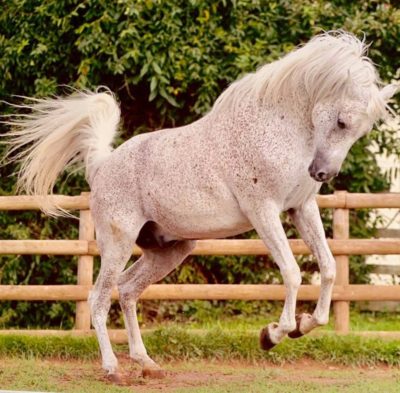Tuwaissan Thaathaa
Jenny Lees posted this superb photo of the Bahraini stallion Tuwaisaan Thaathaa on Facebook the other day.
The Tuwayssan reportedly strain came to Bahrain from Syria in the 1920s, and prospered there. It has disappeared everywhere else, and is now mostly associated with Bahrain and thought of as a Bahraini strain. The strain was formed in North Arabia, and is one of the oldest Arabian horse strains. I personally know of two branches of it: Tuwayssan ‘Alqami (‘Algami) and Tuwayssan Qiyaad.
It will forever hold a special place in my heart because of my beloved Halima (registered in the Lebanese studbook as a Al-Tuwayssa), the grand-dam of which hailed from the ‘Anazah east of Homs, Syria.

Queen Elizabet, and Jenny!, have a wonderful gift there!
ElizabetH!
He really is a handsome lad. I’d glad to see that he’s still kicking. Several times I have returned to Jenny’s website to look for information/photos of the guy, but haven’t been able to find anything in recent visits. (Mind you, I’ve this vague memory of having seen a few things on him and Mlolshaan Mahrous on Jenny’s website, but this might be me misremembering entirely.) Speaking of, do either actually have any foals on the ground? I’m having a hard time finding any information on either of them.
Hello Moira,
Sorry I have been very slow in up dating the Pearl Island website. Both Tuwaisaan and Molshan Mahrous, the two Bahraini stallions presented to HM The Queen by HM King Hamed of Bahrain are well and living on my farm.
I have foals from both. I am thinking about having semen frozen from these stallions for worldwide export. I have already frozen semen from my Bahrain stallion Shuwaiman Al Rais and there is a mare in foal to him in the US. The time has come to share this lovely old blood. I am in Bahrain at the moment but as soon as I get back I will set a website update in motion……
Oh, the curse of horse breeders world-wide, it seems! Good to hear, though – I’ll wait as patiently as I must for updates c: and I wish you safe travels for when you finally depart back to England.
Out of curiosity – I know Shuwaiman Al Rais was made available to breeders in North America and in Europe, but are there plans to make him available in Africa (along with possibly Mlolshaan Mahrous and Tuwaisaan Thaathaa?) I’m thinking predominantly of the horses in South Africa and Namibia, with their extant Bahraini lines that would nick well with these lads. It would also make such a lovely complement to the heavy Nazeer breeding… Not that I’m based in South Africa, but it’s a global effort, this preservation business.
Jenny, if there were a way to LOVE that comment, I sure would!
Gosh, he is a handsome horse and such a lovely colour. What is not to like about the Bahraini horses? They are so beautiful.
Also, I am laughing at myself for being surprised that he is grey, rather than bay; the two Tuwaisans who came to South Africa were both bay, so apparently I have an erroneous association between the Tuwaisan strain and bay!
No,it’s not true information the true information is that al Khalifa family they are receiving kuhaylah Tuwayssan from ibn Haddhal, Shaykh of the ‘Amarat from eanza.
al Khalifa family they received kuhaylah Tuwayssan from ibn hathal the same family of al Khalifa came from it, and they are staying actually in Iraq and not in Syria.
what is the source of your information ya Ahmad?
it Mentioned in stud book volume 1.
I am not sure if this is useful or not but this is what the English version of Volume 1 of the Bahraini stud book says about this strain:
“Early this century, two mares of the Tuwaisah Atiq strain, bred by the Anaza in the Northern region, were brought to Shaikh Hamed bin Isa as a tribute. It was said that the mares were rather insignificant looking and very small in stature – but when mates with the Bahrain stallions, they produced most magnificent offspring. The story is told that when Shaikh Hamed once had prominent visitors from abroad, they had admired some beautiful young foals cavorting outside the guest palace. They had requested to see the dams of these foals. When Shaihk Hamed had the Tuwaisah Atiq mares brought forth, the guests could not believe that such homely mares could produce anything so beautiful – whereupon Shaikh Hamed likened the old mares to the ugly oyster, which when opened will produce a pearl.
The Tuwaisah family today all descend from these two Tuwaisah Atiq mares.”